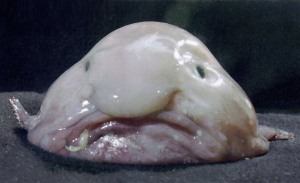“The blobfish is the ugliest animal in the ocean” or at least that is the consensus on many blogs and websites. I am curious if you have another ‘ugly’ favorite. Please share below and in the meantime here are five fun facts about the fish that will never win a beauty contest.

But, please remember beauty on the inside is what counts.
- The blobfish lives off the coast of Tasmania and Australia.
- The body of the blobfish is made up of mostly gelatin, not muscle.
- The blobfish is slightly less dense than the water around it so it floats right above the seafloor.
- Since the blobfish has no muscle it just eats whatever floats near him or her.
- The blobfish may or not be related to Ziggy.
Image (c) wierdimals.wordpress.com
Related articles
- 6 Most Unusual Sea Creatures in the World (tripbase.com)
- Top 25 Animals You Did Not Know Existed (imaginethespirit.wordpress.com)










What people are saying …